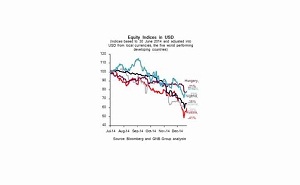
The weekly analysis of Qatar National Bank (QNB) Group said that the Capital flight from developing economies has accelerated, most spectacularly from Russia. A toxic mix of falling oil prices and international sanctions unnerved investors and led to a collapse in the Russian Ruble and equity markets in mid-December.
Measures introduced by the Russian authorities and flatter oil prices have been enough to calm markets for now, said QNB in a press release today.
However, it is likely that the crisis will escalate further. There are a number of commodity producing countries that are also facing potential crises, such as Brazil, Nigeria and Venezuela. There is also a risk of cross-border contagion as investors flee from risky markets as has occurred in the case of Russia, Ukraine and other Eastern European countries, such as Hungary.
Oil prices have fallen around 48% since June leading to a steady deterioration in the outlook for a number of oil-exporting countries, with Russia occupying most of the headlines. The Russian Ruble weakened as falling oil prices negatively impacted the current account. Hydrocarbons accounted for 69% of export revenue in 2013 while the current account surplus is narrow (1.6% of GDP in 2013). Meanwhile, tensions in Ukraine and the steady tightening of US and EU sanctions against Russian banks, corporations and individuals eroded their ability to raise external financing. The combined effect of oil price declines and sanctions unnerved investors leading to capital flight. As a result, Russia fell into a currency crisis and the Ruble crashed 37% in one day on 16 December.
The weakening of the Ruble has had a negative impact on the economy and Russian companies a recession is expected next year and equity markets have experienced a sharp selloff. Moreover, servicing the external debt of Russian banks and corporations (which totals around USD700bn or 33% of GDP) has been made tougher with the Ruble depreciation, causing a drag on the economy and raising concerns about defaults. While a weaker currency can normally boost export competitiveness, this is not the case when the main export commodity is oil where the price is determined internationally. All these factors weighed heavily on the Ruble and equity markets. Since June, Russia’s equity index adjusted for the weaker Ruble fell 41%.
QNB weekly analysis highlighted that the Russian authorities have responded with a number of measures and the Ruble and equity markets have recovered the USD adjusted equity index is up 20% since the trough.
In October, the Central Bank of Russia (CBR) intervened heavily in foreign exchange markets to try and keep the exchange rate within its target range. The CBR stopped intervening in early November and allowed the currency to float freely. However, it resumed interventions in December as the currency collapsed. The CBR also hiked interest rates by 100 basis points to 10.5% on 12 December and followed up with another more dramatic overnight increase of 650 basis points on 16 December. Unfortunately, this was not enough to stop the Ruble collapsing 37% on the same day.
After the collapse, the Russian authorities announced further stabilization measures. The CBR announced a USD18bn recapitalization plan for the banking system and the government imposed new duties on the export of grains to ease domestic price pressures. Furthermore, Chinese officials signaled on 21 December that they would be willing to expand a USD24bn currency swap with Russia that was originally agreed in October. Finally, on 23 December, the government introduced “soft” capital controls limiting the foreign exchange assets that Russian state-owned exporters could hold. Equity markets and the Ruble in Russia recovered following these measures as fears of further collapse receded.
Russia is not the only country facing difficulties and there is a risk that crises could emerge elsewhere. In Nigeria, the naira has weakened 10% since June and the stock market is down 29%. In Venezuela, the black-market exchange rate has weakened around 40%, inflation is over 60%, international reserves are low and the country is running out of basic goods. In Brazil, the dollar adjusted equity index has fallen 22% since June on lower oil and commodity prices and due to political uncertainty around the recent elections.
The Ruble’s collapse had an impact across developing economies, raising concerns about cross-border contagion. The worst-hit were Eastern European countries such as Ukraine and Hungary. Additionally, Bulgarian, Czech, Polish and Romanian equity markets have all fallen by 15% or more since June. These countries have been dragged down by the deteriorating political situation in Russia and Ukraine and were particularly severely impacted by the collapse of the Ruble in December. There appears to be some risk of financial contagion from a balance of payments crisis in Russia to other countries in Eastern Europe.
In summary, oil prices remain low at around USD60/barrel, compared with a peak of USD115 in June. Oil prices are not expected to recover to USD100 levels in the next five years. Therefore, Russia, Nigeria and Venezuela all remain at risk of crisis. This could lead to contagion, weaker currencies and slower growth in a number of developing economies. However, Qatar is unlikely to suffer from contagion as it has been resilient so far. Although, its equity market has been hit by lower oil prices, it is still around 5% higher compared with the end of June.
Source : Qatar News Agency











